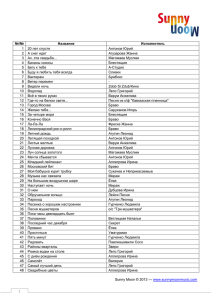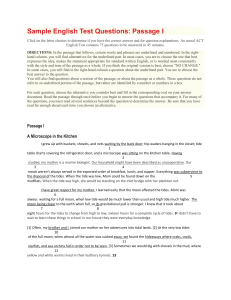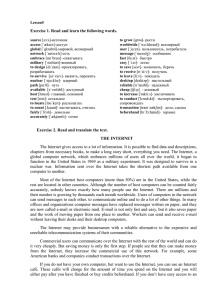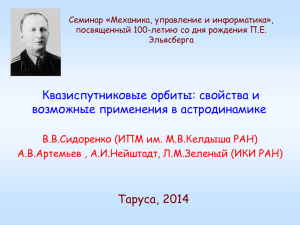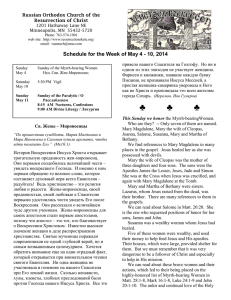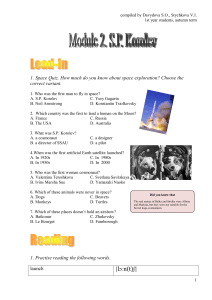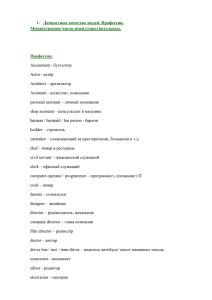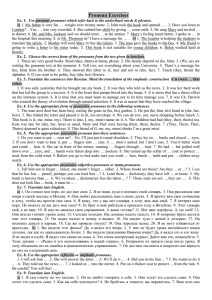Space Age
реклама
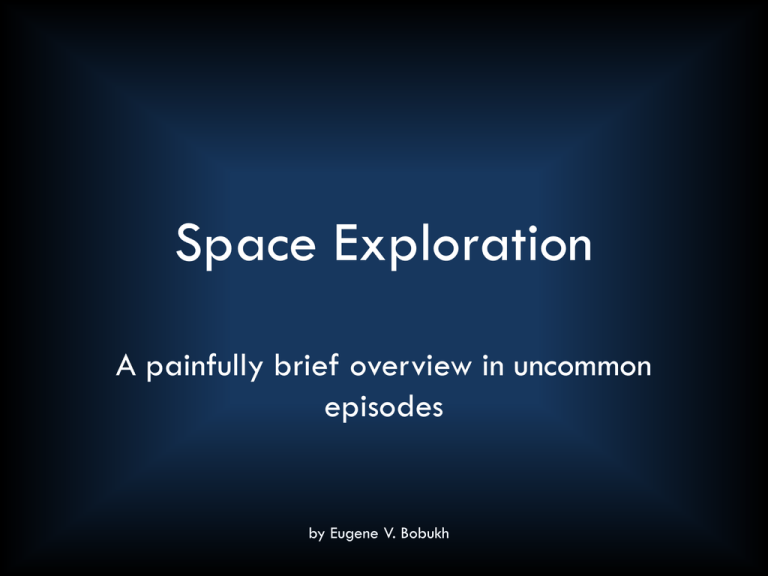
Space Exploration A painfully brief overview in uncommon episodes by Eugene V. Bobukh Intro note Initially, it was a presentation for a party on the 50 years of the first manned spaceflight (Gagarin, 04/12/1961) 139 slides, 5+ hours and good time for 40+ attendees Now I’m asked to put all that in 1 hour, minus Q&A I tried compressing, but each time it ended up like this… So eventually I came to the only option -- -- and I had to be pretty serious about that. So in this presentation you will NOT learn anything about… If interested, go to EugeneBo’s blog at wordpress.com Instead, only a brief set of facts that I personally -- (probably even without any good reason) -consider important, amazing, or just funny will be presented Ready? “Prehistoric” times. The first… • Documented (?) successful (??) human flight propelled with rockets: Lagari Hasan Çelebi, Ottoman Turkey, 1633 • “Space” sci-fi: Somnium by Johannes Kepler, ~1630, Germany • ~1860-1960: Burst of sci-fi describing interplanetary, interstellar and even intergalactic flight • Detailed research on using rockets for space travel: 1903, Konstantin Tsiolkovsky, Russia • Liquid fuel rocket: Robert Goddard, USA, 1926 • Ballistic missile that reached space: Germany, V-2, 1942 1957. Korolev. Sputnik. The plan called for a heavy scientific laboratory, later known as Sputnik 3 (1958). Time pressure, political pressure, production delays => the worldfamous simple sphere. The R-7 rocket used is still in service after some modifications (known as Soyuz today). 1958. First nuclear tests in space. Both USA and USSR. The image in the left is Hardtack-Orange 3.8 Mt at 43 km altitude (so it’s still somewhat atmospheric). The first test over 100 km (Argus, 200 km) done in 1958, too. Banned and stopped in 1962. Most of space exploration is a side product, a debris left after feeding the *military* interests first The price of peace: Project Orion Spaceship driven by nuclear explosions. Yes this is possible. Earth to LRO fallout: 0.1-10 Mt. Saturn manned roundtrip: 1 year in 1970s. Alpha Centauri: ~80 years in 1980s. Proposed: 1946. Incepted: 1958. Serious design and work. Killed: 1963 by Partial Nuclear Test Ban Treaty and other political issues. After Chernobyl and Fukushima, don’t even propose that aloud anymore… 1959. The far side of the Moon. Luna 3, USSR. The first interplanetary probe. Radiation-resistant film was obtained from a shot down American spy balloon A French winemaker who bet that nobody would ever see the far side of the Moon sent 1000 bottles of champagne to the team for 1959/1960 New Year eve 1960. Nedelin disaster. R-16 rocket exploded on the launch pad. 78 (some say 120) perished in a toxic blaze, including Nedelin himself. The worst Soviet space accident. Cause: gross negligence to all safety procedures in an attempt to launch on the stated time. 1960. “There is no life on Earth” First attempt to launch a probe to Mars. Checks at the launch pad revealed that the probe was over the weight limit. Something had to be cut. Korolev ordered an overnight test run of all scientific equipment in the steppe nearby. One device designed to detect the signs of life reported negative and stayed on Earth. It survived the launch failure later known as “Mars 1960A”. (Per Boris Chertok’s memories). 1965. Mars revealed! First ever close-ups of Mars by a robotic flyby probe, Mariner-4. No “channels”, but Moon-like cratered terrain and very thin atmosphere reveled. A great blow to last hopes of finding intelligent life on Mars (yes, many were serious until ~60s!) The total of data returned: 634 Kb, that including 22 pictures Crayons were used to produce first color “prints” of Mars 1965. First spacewalk. Alexei Leonov from Voskhod 2 spaceship, commanded by the 2nd crew member Pavel Belyaev. Inflatable airlock. The 12 minute spacewalk nearly avoided a disaster after Leonov’s spacesuit ballooned in vacuum. Can you make a U-turn in a 8’x3.7’ airlock, while dressed up in a spacesuit? 1965. First space smuggling. John Young secretly smuggled a corned beef sandwich onboard Gemini 3, where the crew attempted to eat it. The crumbles in zero-g have caused serious concern. Young flew a total of 6 space missions between 1965 and 1983 on 4 types of spacecraft, including two maiden flights (Gemini and Space Shuttle). He’s been near the Moon twice and on the Moon – once. That’s if you ask me what a real career should look like 1966. Luna-9 lands on the Moon. First ever landing on another planetary body and pictures from it. Transmission intercepted at Jodrell Bank Observatory and published by Daily Express before the official Soviet news release. 20 days earlier, Korolev died. 1967 Soyuz-1. Parachute system failure and crash upon return, killing Vladimir Komarov. The flight, prepared in unimaginable hurry, was plagued with technical problems and had to be cut short. Apollo 1. “A fire in the cockpit!” A cabin fire during a launch pad test on January 27 killed all three crew members: Virgil "Gus" Grissom, Edward H. White, and Roger B. Chaffee. In pure oxygen, the extreme blaze was over in just 17 seconds. 1971. First space station in orbit. Salyut 1, a space station capable of hosting 3 people for several months. Dobrovolski, Volkov, Patsaev docked the station in June 1971 on Soyuz 11 and worked there for 23 days. While returning to Earth, they all died after Soyuz 11 decompression. They had no spacesuits… 1971. First Mars landing. Mars 3 has landed in 1971 but worked for 15 seconds only, returning no scientific data. The picture returned contains no information. The Lander had a small rover which was also lost. This remains a mystery. Using recent high resolution satellite images of Mars, enthusiasts keep searching for clues… 1972. The last Men on the Moon. Apollo 17. Back then, almost nobody believed that we are not coming back to the Moon in the 20th century. The takeoff video: http://www.youtube.com/w atch?v=cOdzhQS_MMw Why did not USSR go to the Moon? It tried • Late start (~1963). • Short budgets • Glushko vs. Korolev disagreement over fuel • Kuznetsov’s engines: the greatest T/M ratio ever achieved, but the N1 rocket needed 30 of them! • Korolev’s death in 1966 • Poor organization • Secrecy 1972. N1 rocket. “Мы стреляем городами...” (“we are shooting with cities…”) Soviet lunar rocket similar in power to American Saturn V. Four test launches between 1969 and 1972. Each ending with a crash. But… USSR could. It was close. The capability was there! http://www.youtube.com/watch?v=m79UO4HO Qmc http://www.youtube.com/watch?v=k4-CyIBlKNs http://www.youtube.com/watch?v=Ux4TrOEhh0c 1978. Salyut-6 EO-1. Grechko’s cognac. I did not promise it would be all in English История об элеутерококке, рассказанная Г.M. Гречко. Г. ГРЕЧКО: Коньяк я не проносил. Он выплыл из отделения со спортивным бельем. Там было написано "Элеутерококк К". Я сначала по простоте душевной стал спрашивать, что это за " Элеутерококк ". Мне так с улыбкой сказали – концентрированный. Но насчет пил. Это неправильно. Скорее лизал. Вот смотрите. С одной стороны на двоих было полтора литра. Можно упиться. А с другой стороны, 100, если кругло дней, два человека. На 200 человеко-дней. 7,5 грамм коньяка в сутки <…> ни на какую операторскую деятельность это не действовало. <…> Он пился, лизался, еще раз подчеркиваю, 7,5 грамм это столовая ложка. Значит, пока эта фляжка из нержавейки, ее можно было вот так вот сжимать, она выдавала этот коньяк. Но потом там же и жидкость и воздух одинаково ничего не весят. Поэтому они смешиваются. И там образуется пена. А пену уже никак не выдавишь. И как мы ни старались вытащить <…> Не удалось. Мы бросили эту фляжку. А следующий экипаж сказал: а мы допили. Мы говорили: да невозможно. Мы все пробовали. Как помните, мартышка и очки. Мы пробовали все. Ну, а они говорят, что, а мы делали очень просто. Один поднимался под потолок станции, а другой бил его по голове. Горлышко от фляжки во рту. И по инерции коньяк идет в рот, потому что нет веса в космосе, а инерция есть. И они нас справедливо нас так немножко обидели. Сказали, что вот видите, кроме высшего образования, надо иметь хотя бы среднее соображение. Per http://www.echo.msk.ru/programs/korzun/58092/ OK, the translation of previous slide (multiple accounts exist; details vary) • Yuri Romanenko and Georgi Grechko discovered a flask of cognac onboard Salyut6. Fifty ounces, but… for 96 days and 2 people. So they responsibly split it into 0.25 oz/day portions for taste enjoyment rather than anything else. – No way you can get drunk with that • • • Problem: cognac does not pour out in zero g! Solution? Squeeze the flask. Yes, it’s made of steel, but cosmonauts are strong Issue: half and half of cognac and air make foam which resists further squeezing • • So they left half-empty flask onboard and returned to Earth. The next expedition arrived to the station, worked there, returned home and said “thank you!” for cognac. A dialog followed: – – – – • “Did you finish it?” “Yes!” “But how?...” “Well, on top of higher education you’ve got to have some common imagination. One grasps the flask with his teeth… and another gently slaps the back of his head ” Physics rules! 1979-1980. Soyuz 32 & Salyut 6. This is another practical joke in space, by Vladimir Lyakhov and • Valery http://www.denfighter.by.ru/space/history.htm Ryumin who secretly brought a fake orange and a • cucumber “Улетая(possibly на станцию, Ляхов и Рюмин тайно inflatable) to Salyut 6 space station. Then, прихватили в карманах скафандра на орбиту they demonstrated the cucumber to the scientists on Earth, контрабанду - огурец апельсин. И в первом claiming it to be the “crop” и from the hydroponic garden репортаже показали "Земле" этот огурец, якобы onboard. выросший в станционной оранжерее. Ботаники посходили с ума: до этого растение даже завязи Poor scientists went insane as no previous experiments were able давало, здесь at целый огурец. Просили его неas toнеproduce anyаsprouts all; their agitation only increased съедать, начали думать, как его срочно доставить the crew “threatened” to eat the vegetable instead of на Землю. лишь через космонавты delivering it to И Earth. Only afterнеделю a week the prank was признались шутке, показав и апельсин. ” revealed by theвcrew, by also demonstrating the orange. 1975. First pictures from Venus Venera 9 and 10, USSR. The probes survived for ~1 hour and sent back some ~0.1 Mpx BW images. 2003. Don P. Mitchell’s beautiful reprocessing Using the original data from Venera probes, sophisticated image processing and Photoshop, Don P. Mitchell was able to re-map and greatly improve original Venera panoramas in 2003. On the left is the re-processed picture from Venera-13 (1982). But why did not Russia do that? Whose heritage is this? Are Russians good only at “фотожабы”? 1976. Soyuz-23. Launched to Salyut 5 but was not able to dock. On return to Earth, landed into a frozen Tengiz lake. The crew (Zudov, Rozhdestvensky) spent 9 hours in capsule in -20C in water and nearly froze to death and suffocated before being saved by helicopter piloted by Nikolay Kondratyev. 1983. Soyuz T-10-1. The rocket caught fire a minute before launch. Two seconds before almighty explosion, the emergency escape rocket fired, pulling the spacecraft away and saving lives of Vladimir Titov and Gennady Strekalov. http://www.youtube.com/watch ?v=UyFF4cpMVag 1990. Hubble Space Telescope. 10 times the resolution of the best Earth-based telescopes at the time. Thanks to it, we DO have a map of Pluto today. Note: the first successful space telescope was OAO-2 in 1968. 1990. Hubble’s “eyeglasses” “During the polishing of the mirror, PerkinElmer had analyzed its surface with two other null correctors, both of which correctly indicated that the mirror was suffering from spherical aberration. The company ignored these test results…” Cost to fix: probably (???) over $1 billion. Additional corrective mirrors put into the telescope to fix its vision. Left: before. Right: after. 1995. Galileo at Jupiter. First Jupiter’s satellite. Carried a probe to enter Jupiter at 200g and penetrate 150 km of the atmosphere. Main dish failure 134 Kbit/s => 10 bit/s. Saved by brilliant programmers. 1997. Fire on Mir. Faulty oxygen generator caught up a fire. Six people, two emergency 3-seat spacecrafts… but the path to one was blocked by fire! Commander: “my natural move was to open a window…” Heavy smoke, masks. <= can you imagine having to put off <= a fire in a cramped space like this? (Reinhold Ewald’s private conversation on this account in 09/2008) 2002. The end of Buran. There was not enough funding provided even to support the storage hangar. No surprise: finally, it collapsed, killing 8 workers onsite. 2005. Comet “bombing”. 366 kg copper impactor from the Deep Impact probe hit 9P/Tempel comet at 10.2 km/s. Marina Bai, a Russian astrologer tried to sue NASA for $300 million. She claimed that the Deep Impact NASA probe will interfere with her astrology work because the comet would no longer be the same. The case was eventually rejected. http://www.youtube.com/watch?v= XKls-sN56Jk http://www.youtube.com/watch?v= dryvDlB1hWA 1991++. Asian Players. • Hiten, Japan, 1991 – Simple lunar probe with very sophisticated trajectory. • Nozomi (1998-2003) and Akatsuki (2010), Japan – Mars and Venus probes, both failed though. • Hayabusa, Japan 2003 – 2010. – Asteroid imaging, landing, and sample return through a heroic effort. • Chang'e 1 and 2, China, 2007, 2010. – Lunar satellites and mappers. • Kaguya, Japan, 2007. – Lunar satellite and mapper, including Apollo landing sites. – If even after that someone still claims NASA has not been not on the Moon, I’m calling the mental institution. • Chandrayaan-1, India, 2008-2009. – Lunar satellite and impact probe. • 2010: Japanese solar sail IKAROS reached Venus! 2009. Will space debris block the access to low Earth orbit? First catastrophic collision of satellites: 2009, Iridium 33 vs. Cosmos 2251, @ 11.7 km/s 600,000+ objects over 1 cm 19,000+ tracked Numerous impacts seen on Shuttle, Salyut, Mir, ISS Debris => collisions => debris. Worst “runaway” case: ∂n/dt ~ n2 n(t) ~ (t – tDOOM)-1 Why fly? • Comsats, weather, maps, military? – Need neither humans nor a flight too far. • Mine resources? – Nothing (maybe except for 3He) comes even close to being economically or energetically profitable • Science, planetary research, astrophysics? – Robots are cheaper, easier to protect, and become increasingly smarter. – You don’t seriously propose that a Man’s Mission in space is of a repairman? • Reduce Earth population? Colonize Mars? – At $1010 per person? • Populate Antarctica or Sahara first… – Radically different from Columbus’ situation who arrived to a *habitable* place! • Meet other civilizations? – Not in Solar System and not via interstellar flight in any foreseeable future. • Develop new technologies? – Possible. Better solution: give a talented team a bunch of $$$ and ask to build a perpetuum mobile. The flow of engineering discoveries is guaranteed to never end! There seems to be no reason Yet reality disagrees People die to climb Everest Some live for years in Antarctica Some spend years studying Neptune satellites Some seriously propose one-way missions to Mars A glimpse from the past: artists’ impressions of Mars polar cup area: By Georgy Kurnin, 1974 or much earlier. Has nothing to do with the reality. By Reuters Pictures, 2008. Scientifically correct. If you knew nothing about Mars, which picture would’ve likely convinced you to go there? If you think about that… (and I don’t claim to know the ultimate answer) There is a demand for dream and inspiration, as strong as for food and oxygen. When inspiration is the demand, art is the response Yes, current manned spaceflight is… a form of art! Extremely expensive, risky, but incredibly inspiring one. Yes, there is science and practical part here – and something more important: food for spirit. In some sense, this picture indeed was worth $25B at the time. It paid back to America way more than that – with international prestige, recognition, and most importantly with people who value science and are always looking up the skies for the unknown. Thank you for your attention! Questions? Backups 1973. Skylab. Skylab, American space station, 1973. Big and heavy (made from modified Saturn V 3rd stage), almost lost on launch and had to be repaired by the first expedition. Garriott decided to play a little prank to stay busy on Skylab <…> He'd taken a portable tape-recorder offworld, surprising Mission Control with the sound of his wife answering the communications. When ground controller Robert Crippen <…> demanded to know what she was doing up there, she replied that she'd wanted to bring the boys some fresh food and visit for a few days. 1998+. International Space Station. Modular design following Mir. The largest man-made object in space (400+ tons) The largest international cooperation in space. Cost: over €100 billion. Continuously habituated since 2000. 60+ expeditions, over 297 visitors, 15 pressurized modules from 5 countries.



